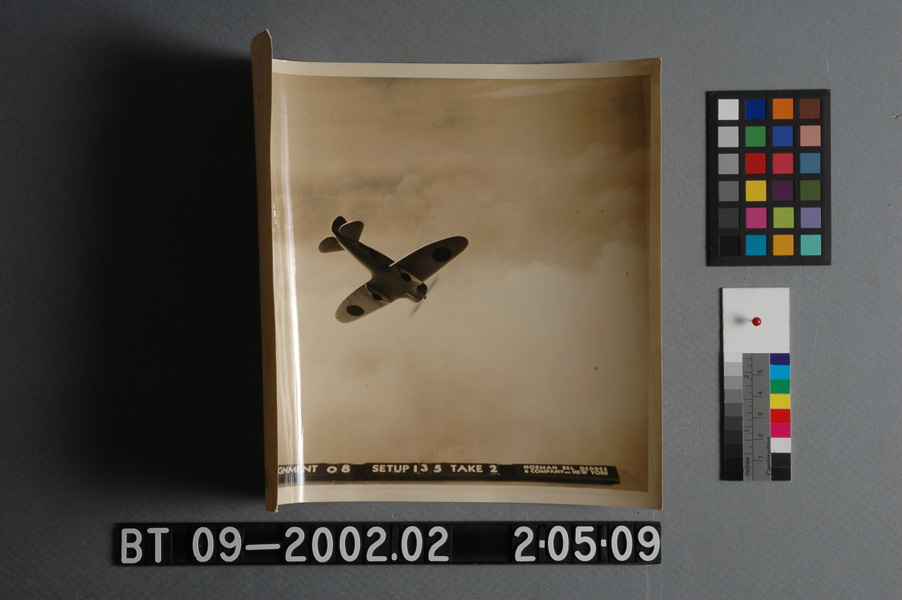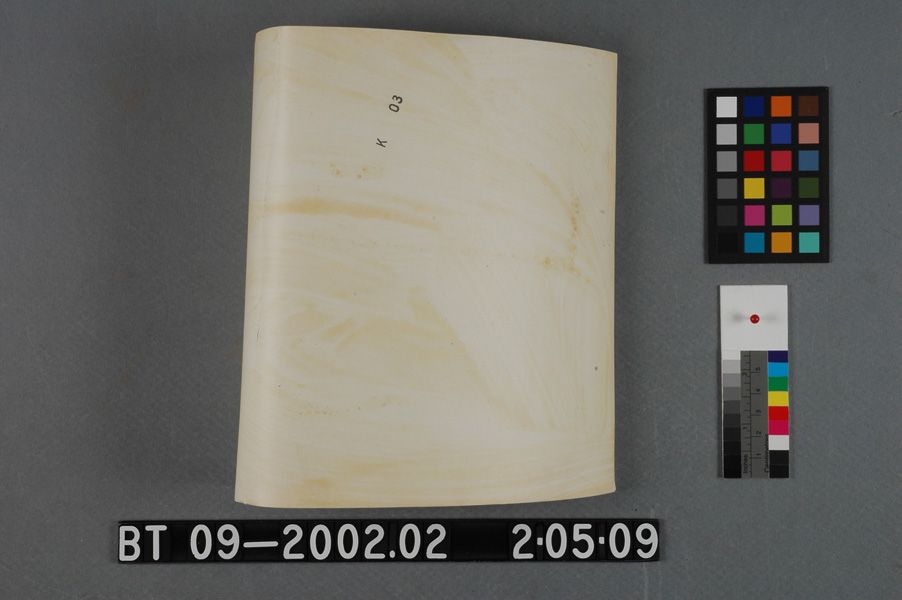Photo Treatments
Norman Bel Geddes Gelatin Developing-out Prints
Surface cleaning, humidification and flattening, mending, and consolidation
Photo Documention
Treatment 1
- Before
- After
Treatment 2
- Before
- After
Treatment 3
- Before
- After
Treatment 4
- Before
- After
Click thumbnails to view images.
Treatment Reports
Treatment 1
(See PDF Downloads for other treatments)
Date: April 23, 2009
Master Control number: #09-2002.01
Owner/Custodian: Helen Adair
Address: Harry Ransom Center, University of Texas at Austin
Title/Subject/Description: Gelatin Developing-out Print on fiber-based paper
Creator: Norman Bel Geddes & Co., New York (NBG)
Approximate dimensions (hxw):8 1/16 in. x 10 in
Conservator: Beth Antoine
Supervising Conservator: Barbara Brown
Description
The silver gelatin developing out print in black and white portrays a two-man airplane model suspended in front of a backdrop of a cloudy sky. The view of the plane is from the top as it is flying down and toward the right. The print has a glossy surface finish, and there is a 5-7mm margin around all four edges of the image. Lines of retouch extend from the wings and the tail of the plane to the top edge of the image, apparently to cover wires used to suspend the model. A black label with white text, listing the subject of the image and the photographer, appears at the bottom edge of the image area. There is a black stamp on the verso, which reads, "K 02."
Condition
The print is in poor condition overall with severe planar distortion, tears, folds, creases, loss of emulsion, discoloration, surface grime, and adhesive staining on the verso. The discolored photography paper is cream, and the silver image material ranges from cream to nearly black with an overall warm tone, likely caused by poor processing. Tight folds appear at each bottom corner and each have an associated tear, likely caused by handling. The tear on the left is two inches from the bottom edge and extends two cm from the left edge and into the image area. On the right, the tear extends only one centimeter, remaining in the margin area. Two tight creases extend vertically the full height of the sheet. One is found just to the right of the center; the other is two inches to its right. The paper is severely weakened near the middle of the crease on the right. The creases have caused the emulsion layer to crack severely and buckle as the paper curls upward. There are several small areas of emulsion loss along the creases and associated cracks. The verso of the sheet exhibits staining from what appears to be a brushed-on adhesive, likely rubber cement from a previous mount.
Testing
The stamp ink on the verso was tested for solubility in de-ionized water and ethanol with a soft brush and chromatography paper. No offset was observed.
The retouch was tested for solubility in de-ionized water with a soft brush. No movement was observed.
The adhesive residue was tested for solubility in de-ionized water and ethanol. The residue readily softened in ethanol on a soft brush.
Comment
The print can currently not be housed flat in a folder due to its distorted and fragile condition. The objective of the treatment is to stabilize and flatten the object to allow for safe handling and storage.
Photography
Digital images were taken of the recto and verso before and after treatment in normal and raking light.
Treatment Proposal
- Surface clean as possible.
- Humidify and flatten overall.
- Reduce creases with mending tissue on the verso.
- Mend tears.
- Consolidate cracks in emulsion if needed using a fine brush and a dilute gelatin solution.
- House in archival quality folder.
Treatment Performed
- Humidified overall in humidity chamber for two hours. Locally weighted with glass weights lined with polyester webbing as needed to encourage tight creases to unfold. Dried under weight between blotters, Hollytex, corrugated boards, and press boards. Left one week. (2 hrs.)
- Locally humidified creases and folds with de-ionized water on a soft brush. Flattened locally under weight until dry. (30 min)
- Mended tears and reinforced crease on the back with one layer of Kizukishi tissue followed by one layer on Lens tissue adhered with de-ionized water diluted wheat starch paste. (3 hrs.)
- Reduced surface dirt and accretions mechanically with micro-spatula and soft brush. (15 min.)
- Consolidated flaking emulsion with 2% gelatin solution under magnification. (2.75 hrs.)
- Humidified overall in humidity chamber for two hours. Dried under weight between blotters, Hollytex, corrugated boards, and press boards. Left one week. (2 hrs.)
- Housed in Mylar sleeve inside archival quality folder. (15 min.)
Total Treatment Time: 10.75 hours
Materials Used
Kizukishi tissue
Lens tissue
Mylar
Ethanol: Chemstore, UT Chemistry Department Research Storeroom; Austin, TX
Reemay polyester webbing: University Products; Holyoke, Massachusetts
Cosmos blotting paper: Rembrandt Graphics; Rosemont, New Jersey
Chromatography paper: Thomas Scientific; Swedsborough, New Jersey
Cotton: Chemstore, UT Chemistry Department Research Storeroom; Austin, Texas
"Zin shofu" Japanese precipitated wheat starch: Hiromi Paper International Co.; California
Gelatin, purified grade, 275 Bloom, Lot No. 922707, CAS 9000-70-8: Fisher Chemical /Fisher Scientific































